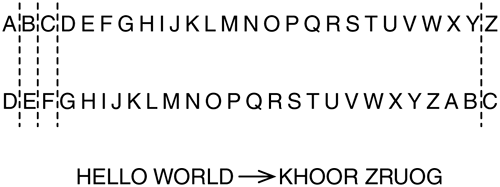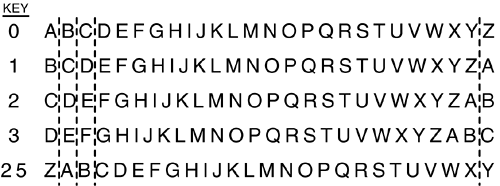Common Security Technology
Modern software architectures make use of several technologies for supporting system security. This section is a brief look at message digests, Secure Socket Layer (SSL) and digital certificates. To understand these you must first look at data encryption.
Data encryption means converting the data so that it can only be decrypted and read by authorized users. Encrypting data means applying a numerical algorithm that converts the data into another form that can, at a later time, be decrypted to recover the original data. Encryption algorithms typically use a variable component (such as a pass phrase) to “seed” the conversion; this variable component is known as the key. Symmetric encryption is so called because it uses the same key to both encrypt and decrypt the data. Asymmetric encryption uses two keys; one key to encrypt the data, and the other to decrypt the data. Asymmetric encryption is commonly known as Public Key Encryption (PKE) because one key can be made public.
Symmetric encryption predates asymmetric encryption, is generally faster and, therefore, is still the most common form of encryption used.
Symmetric Encryption
Symmetric encryption uses one key to both encrypt and decrypt the data.
One of the simplest cryptographic techniques is the Caesar cipher (named because Julius Caesar was reported to have used it). The Caesar cipher simply replaces each letter of the alphabet by another in a mathematically consistent manner (for example, replacing a letter by the one three positions further on, so that A is replaced by D, B by E, and so on, with the last three letters replaced by the first three of the alphabet). Figure 15.1 shows the Caesar cipher.
Figure 15.1. The Caesar cipher.

The Caesar cipher is a specific example of a simple shift substitution cipher when one letter replaces another. A different cipher is obtained by shifting the alphabet by more or less than three letters, as shown in Figure 15.2.
The number of letters the enciphering alphabet is shifted by is called the cipher key. Given an encrypted message, anyone with the key can decipher the message. Because the same key is used to encrypt and decrypt the message, this is known as a symmetric encryption algorithm.
In programming terms, each letter is represented by a number, and the substitution cipher simply adds the key number to the value of each letter to get the encrypted form. The resultant number must be adjusted to map the last few letters (X, Y, and Z) onto the first few (A, B, and C) letters. This is a very simple algorithm.
In real applications, symmetric algorithms use sophisticated algorithms with number keys of 56 or 128 bits (which for 128 bits means an integer with approximately 40 digits). The algorithms used are usually well known but, due to the size of the keys used, they cannot be easily reversed. In other words, without the key, the original plain text message can only be recovered by applying each possible key in turn. As long as the key is a large one and the encryption algorithm is sufficiently robust, the time taken to crack the cipher with a brute-force method attack, such as applying every possible key, can be hundreds of years.
One of the most widely used symmetric encryption algorithms is called DES (Data Encryption Standard).
Symmetric encryption is used to ensure both data confidentiality and that only the intended recipients, who know the decryption key, can recover the original data.
The big problem with symmetric key encryption is distributing the key to the intended recipients in a secure manner. If a third party intercepts the key when it is distributed, they can also decrypt the message. Asymmetric encryption provides an alternative approach to data encryption that can also solve the problem of secure symmetric key distribution.
Asymmetric Encryption
Asymmetric encryption uses different algorithms to symmetric encryption and requires the use of two keys. One key is used to encrypt the data, and the other is used to decrypt the data. The two keys can be very large numbers, with modern systems using numbers of 1024 bits (an integer with approximately 310 digits). Asymmetric encryption is called public key encryption due to the way the two keys are used.
One of the two keys used in asymmetric encryption is made public, while the other is kept private to the owner. The keys are therefore known, respectively, as the public key and the private key.
If data is encrypted with the public key, only the owner of the private key can decrypt it. This approach is used to ensure data confidentiality but is restricted to supporting only one recipient per message. If the private key was known by more than one person, it would undermine the other benefits of using asymmetric encryption such as non-repudiation.
In contrast, using symmetric key encryption allows one message to be distributed to several recipients, as long as each recipient knows the key used to encrypt the message. Distributing the keys used in symmetric encryption is a major problem, because the keys have to be distributed in a secure manner. An attacker obtaining the keys can decrypt the message to recover the original data.
Another use of asymmetric encryption is to support non-repudiation. If a message is encrypted with the private key, it can only have originated from the key owner. Anyone can decrypt the data using the public key with the knowledge that it can only have originated from the owner of the private key. This use of asymmetric encryption is the basis of digital signatures.
Unfortunately, asymmetric encryption is slow compared to symmetric encryption. To improve performance, it may be desirable to use symmetric encryption. The problem here is how to distribute the encryption key to each recipient securely.
A common solution to distributing a symmetric encryption key is to to pass the key with the data. To make this approach secure, the recipient's public key is used to encrypt the symmetric key passed with the encrypted data. The recipient uses the private key to recover the symmetric key and then uses this symmetric key to decrypt the actual data. This technique enables large volumes of data to be encrypted quickly while distributing the encryption key in a secure manner. Secure Sockets uses this technique to encrypt TCP/IP network traffic.
SSL and HTTPS
The Secure Sockets Layer (SSL) is an implementation of public key encryption in TCP/IP networking. TCP/IP communication uses a technology called sockets (sometimes called service or port numbers). All standard TCP/IP services advertise themselves on a fixed socket or port--FTP on 21, Telnet on 23, HTTP on 80, and so on. You have seen socket numbers when using the J2EE RI Web server that runs on port 8000.
http://localhost:8000
Ordinary socket communication uses plain (unencrypted) data. Any user that can monitor network traffic can read any usernames, passwords, credit card details, bank account information, or anything else passed over the network. This is obviously an unacceptable situation from a security point of view.
One solution to securing confidential data over a network is to encrypt the data within the application. This is an inconsistent solution because some applications will be secure while others are not.
Another solution is to encrypt all network traffic. Because encryption adds an overhead to the network communication, this will affect overall performance and is unnecessary when data does not need to be encrypted.
The workable solution is to seamlessly provide network encryption only for applications that require secure data transmission. Using this approach, any application can encrypt confidential data simply by using the encrypted network communications instead of the usual plain text data transfer. Each application decides if encryption is needed but does not have to implement the encryption algorithms.
SSL is a network encryption layer than can be used by any TCP/IP application. The application has to connect by using a secure socket rather than a plain socket, but otherwise, the application remains unchanged.
Hypertext Transfer Protocol Secure (HTTPS) is the name given to the HTTP protocol when it uses a secure socket. The default port used by an HTTPS is 443. When a URL specifies the HTTPS service, the Web browser connects to an HTTP server but uses SSL to encrypt the data. All the popular Web browsers indicate on the status line when SSL communication is taking place – typically, a closed padlock is used to show that data is encrypted.
Online credit card verification services and banking systems use SSL communication.
Encryption is used primarily to ensure confidentiality of data but sometimes only data integrity is required. The data is not confidential but the data received must be guaranteed to be the data transmitted. Checksums and Message Digests provide a simple and fast mechanism for ensuring data integrity.
Checksums and Message Digests
Data integrity is usually achieved by providing checksums or digests of the data. The data in a message is subjected to a numerical algorithm that calculates one or more validation numbers that are transmitted along with the data. The recipient receives the data and applies the same algorithms to the data. As long as the recipient's calculations yield the same numbers as those transmitted with the data, the recipient is reasonably confident that the data is unchanged.
Checksums use simple algorithms and are primarily intended to detect accidental corruption of data. Message digests use sophisticated algorithms that are designed to prevent deliberate changes to data. The algorithms used in a message digest generate many digits and are chosen so that it is virtually impossible to change the original data without changing at least one digit in the calculated digest.
There are several digest algorithms in use, with Message Digest version 5 (MD5) currently one of the most popular. The MD5 specification can be found at http://www.ietf.org/rfc.html.
A common use of digests is found when downloading applications from the Internet, where many of the applications have an associated signature file. A signature file is used to validate the contents of the application file (the one it signs). Signature files usually contain one or more digests of the file they are signing. After downloading the file, a conscientious user can also download the signature file and check the integrity of the download file by calculating the digest of the file and comparing it to the value in the signature file. Programs to calculate digests are widely available on the Internet.
Digital Certificates
Digital certificates are specified by the X.509 international standard and define a format for storing public keys and other information about an entity (it could be a user, a program, a company, or anything that has a public key).
The official specification for the X.500 Directory Service is available from the International Telecommunications Union (ITU) Web site at the following address:
http://www.itu.int/rec/recommendation.asp?type=folders&lang=e&parent=T-REC-X.509-200003-I
Digital certificates are often sent with a request for data so that the server can encrypt the data with the recipient's public key.
Digital certificates must be signed by a Certification Authority (CA) to prove their validity. A signed digital certificate contains a message digest of the certificate encrypted using the CA's private key. Any recipient of the certificate can decrypt the digest using the CA's public key and verify that the rest of the certificate has not been corrupted or modified.
Digital certificates can be used to ensure authentication, confidentiality, and non-repudiation.
CAUTION
Valid Digital Certificates have been erroneously issued to individuals spoofing the credentials of trusted companies. A Digital Certificate is only as trustworthy as its Certification Authority.

